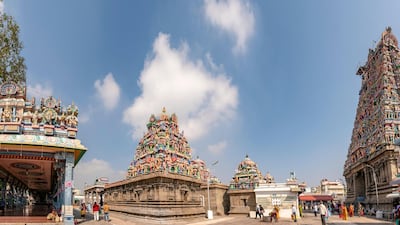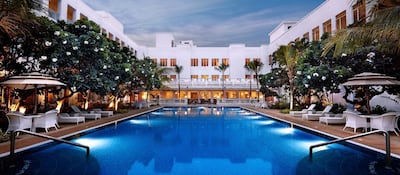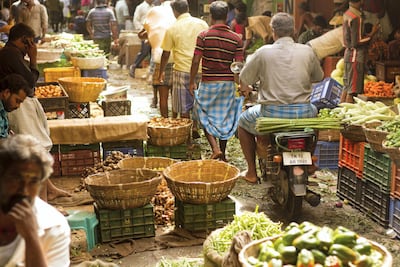There's an old Tamil proverb that goes something like this: "He drinks mind-milk thinking that he can rule the world". Mind-milk is any foolish hope, a bit like the one that crosses my mind one afternoon as I sip strong South Indian coffee from a steel tumbler at an earthy Triplicane cafe.
Here in one of Chennai's oldest neighbourhoods, I'm enjoying the distinctive taste of the local coffea arabica, as it's called – its ground beans typically mixed with chicory, and the thick dark mixture added to boiled milk rather than water. Gazing out at the bewildering swirl of endless traffic, my "foolish hope" is simply to cross the road and make for the gleaming sands of Marina Beach, where crowds slurp ice cream and nurse chargrilled corncobs.
But there is one golden, even cautionary, rule for tackling traffic in Chennai, if not India generally: everyone has the right of way all of the time. So after gauging the frantic ebb and flow of honking buses, lorries, cars, auto-rickshaws, bicycles and handcarts over another coffee, I decide only braver, possibly foolish, souls would attempt to cross on foot. Hailing a tuk-tuk, I join the tide for a half-kilometre ride to the beach.
Chennai is the great international gateway to South India. For businesses, especially those in the IT and automotive sectors, it is a vital thriving hub, while other visitors may well be here as medical tourists, tapping into the reputation and expertise of Chennai's doctors and consultants.
Regular travellers typically see it as a staging post; not quite an utter chore but hardly a worthy destination either. Aided and abetted by a fine hotel, Taj Connemara, I was keen to give it a try.
Officially called Chennai since 1996, for centuries it was known as Madras. That name probably derived from a small fishing village near a slender strip of land that became one of Britain's first toeholds in the subcontinent. The British – strictly the East India Company – yearned for a port on the Coromandel Coast and eventually acquired one in 1639. Within five years, the growing trading outpost was strengthened and named Fort St George. Around its walls sprung "White Town", a British and European enclave beyond which sprouted the colloquially named Black Town, where locals lived. Everyone knew where they stood, stayed and slept.
Dotted with a cornucopia of mainly Raj-era heritage buildings (in India only Kolkata has more), modern Chennai could be a prodigious architectural depository, but for the vagaries of their preservation. Consider the fire and storm-damaged Indo-Gothic General Post Office and weep; another fire in 2014 seriously damaged the magnificent State Bank of India building nearby. Stalled renovation of the Romanesque Victoria Public Hall (where the city's first films were screened in the late 1800s) now looks dreadful. The list goes on.
Yet many of these buildings are still used and some are virtually pristine. Stubbornly avoiding the new and expanding metro (which clearly moderates the average Chennaite's commute), I brave the seething traffic to pound the streets.
From the handsome Indo-Gothic edifice of Egmore Railway Station and the almost unnatural calm of St Andrew's Kirk (modelled on London's St Martin-in-the-Fields), I head on past the dazzling white Ripon Building, its Italianate facade capped with an elegant clock tower. Almost alongside it stands Chennai Central, a magnificent Gothic Revival masterpiece that is used by more than half a million people every day. In 2005, plans to lighten its colour from red brick to pale brown led to protests and railway authorities stuck to the colour that had adorned the station since construction in 1873.
Tucked away behind Parry's Corner, the domes and cupolas of the Madras High Court are among the city's best examples of East-meets-West architecture. This court complex is 50 metres tall, with a central tower that was designed to be visible even way out at sea.
For those looking to gain a clearer sense of how modern Chennai came to be, Fort St George lends shape and substance. Now a large and leafy complex of government and naval buildings (plus India's oldest Anglican church, St Mary's Church), its main entrance still stands alongside a sea-facing bastion and flagstaff resembling the prow of a ship. Aptly enough, security is tight and bags are checked.
Once an officers' mess, Fort Museum is the prime draw here. Amid the displays of weaponry, uniforms, medals and porcelain, I make a bee-line for the ground-floor galleries. Models and plans sketch the fort's development from a modest square structure with fin-like corners to a huge compound with strangely angular walls and chevron-shaped bastions. Upstairs are galleries that feature romantic aquatints by Thomas and William Daniell. These artists undertook extraordinary journeys across late 18th-century India and their exotic depictions of mosques, temples, palaces and pastoral scenes whetted the appetites of many a budding soldier-sahib.
Tracking these Raj-era highlights, it seems apt that I am staying at one of South India's oldest hotels. Reopened last autumn after extensive renovations, the Connemara has long been an institution for the city's great and good. What began as a cosy retreat in palace gardens owned by a nawab, became the Imperial Hotel in 1854 and the Connemara in 1890. Named after Lord Connemara, who was governor of the city in the late 1880s, or possibly his wife at the time, who stayed here for months as their marriage fell apart, it's a property that elegantly merges nostalgia with Art Deco sensibilities. Famous Sri Lankan architect Geoffrey Bawa's remodelling of its public areas in the 1970s remains virtually untouched.
One morning over breakfast, I briefly chat to a middle-aged British couple touring Tamil Nadu and adjoining Kerala. They are also on something of an ancestral quest; a great-grandmother was born in Chennai and through some old letters they hope to locate addresses and homes to reconnect with an exotic fragment of family history. "It's harder than we thought," admits the husband. "Street names have changed, addresses are confusing…"
"We get a few guests here on the ancestral trail, just like in my own home city of Lucknow," says general manager Ahmar Siddiqui. They are significant cities in the story of British India."

I don't wish to obsess over the Raj's illustrious ghosts. Connemara often arranges tours for guests to explore other facets of the city, from street food and jewellery to its dense bazaars, on foot. The next morning, I hover outside the soaring gateway of the imposing Kapaleeshwarar Temple awaiting my guide, Lakshmi Shankar. Here in the city's Mylapore district, Shankar's tour started with an "anatomy of a temple" walk. As we repeatedly orbit its large courtyard, she explains some of Hinduism's complex rituals and beliefs.
Just beyond its secondary entrance is one of the state's largest temple tanks, a pool of water lined with masonry steps traditionally used for ritual bathing and ceremonies. Shankar explains that about two centuries earlier the land for this tank was given as a gift to the ancient temple by the Nawab of Arcot (a relatively short-lived but influential dynasty that can be traced back to the second Caliph, Omar ibn Al Khattab, in the seventh century). There was one condition: the city's Muslims could also use it for rituals during Muharram. For a day or two each year, Muslims and Hindus can stand side by side observing their faiths, a heartening tradition of tolerance that has more-or-less endured since the 1800s.
We move on to nearby San Thome Cathedral that, despite the name (reflecting its 16th-century Portuguese origins), was rebuilt by the British in the 1890s. The whitewashed Neo-Gothic facade is all very well, but Shankar says that it is also one of only three churches in the world to be built over the tomb of an apostle. St Thomas landed in Kerala in the 1st century and eventually made his way towards the Coromandel Coast. He was killed on a hill (now called St Thomas Mount) in the southern suburbs near Chennai's airport but was buried in Mylapore.
Pausing for (yet more) coffee in a local cafe, Shankar urges me to visit the Government Museum, a huge and seemingly motley complex of buildings dominated by the circular Museum Theatre. If you only see one gallery, it should be the one devoted to Chola bronzes, an astonishing collection of 8th to 12th-century sculpture made using the "lost wax" (or cire perdue) technique of casting with bees wax and clay moulds. The dancing gods and goddess might not be to everyone's tastes, but the sheer artistry and skill is admirable.
Later, dawdling in a gallery devoted to South India's almost forgotten tribal groups, I stumble across one of the strangest exhibits I've seen in an Indian museum. Displayed almost as an afterthought in a dark corner are two large gnarled and tapering wooden beams, the upright beam running through the horizontal one. Used by tribal Gonds to help propitiate the gods and safeguard the tribe's prized turmeric cultivation, hapless human offerings were stupefied with liquor, lashed to the horizontal beam and spun vigorously until death. The last "meriah" sacrifice occurred in 1852 and a label notes that when the device was exhibited in 1906 during a visit of the prince of Wales, Gond groups became visibly excited.
For a more engaging window into the region's mainstream heritage, I head out of the city. About 25km south, beside the Bay of Bengal, is Dakshinachitra. Described as a heritage centre with craft workshops, exhibitions and cultural performances, for most visitors its main attraction is the charming array of traditional homes representing some of South India's varied vernacular architecture.
Be it a Muslim trader's house from Karnataka, a weaver's abode from Andhra Pradesh or a Syrian Christian home from Kerala, all were saved from demolition, carefully dismantled and painstakingly rebuilt on-site. It's too neat to resemble even an idealised village, but perhaps the most striking aspect is the economical beauty of these homes and a sense that their occupants lived well, if not always wealthily.



